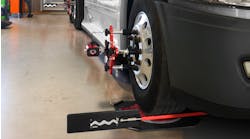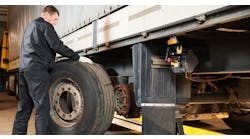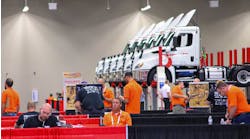This is Part One of a two-part series.
According to DJ Painter, a vehicle technician for nearly a decade, one of the worst feelings on the job is watching a familiar-looking truck being dragged back to the shop on a wrecker’s hook.
Your internal monologue may ask “Did I work on that truck?” before a check of the vehicle’s repair history confirms you were indeed responsible for this “comeback.” That’s the name for when a shop releases a truck with a clean bill of health, but it’s not at 100% and must return for further evaluation. A shop may also classify a comeback as an inaccurate repair caught in the shop but that causes further downtime.
Trucks are complex machines, and sometimes issues are so hidden they’re easy to miss. Other times, though, it’s pure mechanical malpractice.
“I’ve definitely seen guys leave a drain plug loose in the bottom of an oil pan, and that can cause total engine failure or failure of the differential,” explained Painter, now the Technician as a Service lead at Noregon.
The target is always perfection, and as a professional technician, thinking that you not only missed the bullseye—but failed to hit the target completely—can evoke a physical response.
“It’ll make you sweat because you really want to take pride in your work,” said Painter.
On a personal level, the shop may dock your pay.
“In some shops, that’ll keep you from getting your bonus, so even though you had 110% productivity, you won’t make your bonus, because you had a comeback,” Painter said.
Your reputation will also take a hit with the other technicians. “Shops are kind of a cutthroat environment, so you’re gonna get trash talked, too,” he added.
The inaccurate repair can have a domino effect on the fleet side too, where logistics windows have become tighter and being off target cuts into the bottom line.
“If you miss that window, you’ve lost all the profits on that haul,” said Ben Johnson, former director of product management at Mitchell 1. The diagnostic marksman noted some fleets strategically place backup trucks near routes to ensure their customers’ orders are fulfilled, but “that’s an expensive solution.”
In his role at Noregon, Painter seeks to help fleets and shops avoid costly redundancies by backing up the diagnostics provider’s customers remotely during tricky troubleshooting jobs, helping them always stay on target to fix the truck and get it back to work. And just like Painter talks technicians through diagnostic jobs, we’re here to guide your maintenance operation through identifying the root causes of inaccurate repairs and how to improve your “aim” overall.
Measuring the problem
Before trying to rid your shop of comebacks, you should first figure out the size of the problem.
“Comebacks in the fleet business are not very prevalent, but when one happens, it is always a challenge,” said Jenny Baker-Ford, fleet services manager at Mike Albert Fleet Solutions (MAFS).
She added the worst-case comebacks are also the most avoidable if the technician double-checks their work. These include loose oil drain plugs or partially opened air filter boxes.
MAFS doesn’t specifically track these, as comebacks don’t appear as an issue, but the maintenance management provider does respond to negative online feedback from drivers within 72 hours and works with contracted shops to resolve any complaints.
Tracking repair misses in general can be difficult because that feedback isn’t always provided—and culpability is not always apparent. This is especially true with long-haul trucks that rarely get serviced at the same place twice.
Read more: Four ways to regain customer trust after a comeback
“It’s hard to look through the records to know whether the first time a vehicle was brought in it was misdiagnosed,” Johnson said. “Was the wrong part hung on it? Or were there other contributing factors that just didn’t get caught?”
Johnson said using Vehicle Maintenance Reporting Standards system codes, which group related parts to shared systems through a numerical system, can help when combined with repair history tracked in fleet management software. For example, Johnson explained that if a truck got a new water pump in St. Louis and then the hose attached to the water pump had to be replaced in Kansas City, it’s likely that the initial replacement was not done correctly.
Painter noted that you can also look at diagnostic fault code history to track comebacks. He noted Noregon’s JPRO stores fault history, and though you won’t get specific alerts, you can look for anomalies such as a DTC indicating a loose pin tension being cleared dozens of times. That could indicate a technician did not adequately reconnect wires.
In the collision space, the definition of a comeback can be broader. Supplemental work, or repairs not necessarily listed on the original estimate, can be harder to detect. In the case of a front-end collision, damage to the hood is obvious, but how did the impact affect internal parts?
“If a cooling pack gets pushed backwards, maybe there’s hidden damage that is not visible without partial disassembly,” explained Doug Orr, product manager of AdjustRite, PPG’s estimating software solution. “These may include damaged parts such as a transmission cooler, hoses, fans, brackets, supports, and wiring.”
If you miss these initially and need to wait on parts, that extends unplanned downtime for the fleet. And if structural damage is missed until the end, that can push a repair out several months.
According to data presented at the Collision Industry Conference, out of 26 repaired consumer vehicles studied, 90% were totaled after inspection, with half having unaddressed frame damage. And they had 3.5 times the cost versus the original estimate.
“It’s a pretty damning report, in terms of the quality of the repairs,” asserted Frank Terlep, VP of ADAS (Advanced Driver Assistance Systems) solutions at Opus IVS, a provider of collision diagnostic, estimating, and training tools. “There’s a fairly large percentage of vehicles not being properly repaired.”
Commercial vehicle body shops are also limited because “unlike the car side, the big truck side doesn’t have as many guidelines,” explained Jeremy Shuey, body and paint shop manager at Housby, a Des Moines, Iowa collision shop.
With more oversight needed, Housby expands the definition of ‘comeback’ to include trucks that haven’t left the shop yet.
“We have one shot to get [the damaged area] disassembled, look the vehicle through, and make sure we have every part that we need,” Shuey said. “Anything thereafter is almost like a comeback.”
Comebacks are rare at Housby, Shuey said, but when found, are logged on an Excel spreadsheet and addressed at bi-weekly meetings to ensure that techs are aware. “When we do point these things out, it’s not ammunition to fire at the guy,” he explained. “It’s us saying, ‘This didn’t meet our standard, and this is how we can get it to meet our standard.’”
Rooting out root causes
After determining how often inaccurate repairs occur, find out why they happened. According to the experts we spoke to, leading causes include inexperience, distraction, and the pressure from fleets to complete a job fast.
“You want it quick, done right, or done cheap? Because you can’t pick all three,” Orr offered.
The more repairs a tech has notched, the better prepared they are to offer things done quick and right, though.
“Most technicians will tell you that their biggest tool in their tool belt is their experience,” Johnson noted. He explained that especially as new technology appears on commercial vehicles, even veteran techs will run into ravenous repair jobs “that eat their lunch.” These are the “weird diagnostic issues” where the tech went over on hours and likely didn’t make money.
Experienced techs know they will make that money up the next 15 to 20 times they see that scenario and handle it more quickly, Johnson said, meaning they have to take the time required to do the job right. This isn’t always intuitive to newer techs, who Noregon’s Painter said feel “a lot of pressure to get something done in a timely manner, so they can make their money as well.” If this pressure is affecting accuracy, re-evaluating hourly versus a flat-rate pay structure for new techs may be helpful.
“Flat rate works great for the techs who are used to it and have been turning wrenches for a while, but when you’re new in the industry, and you’re still trying to figure this stuff out, I feel like it’s a very bad choice starting out,” Painter said.
Another thing to watch out for is incentivizing productivity without controlling for quality. Denver-based shop Iron Buffalo has several incentives to help bring out the best in their technicians and supervisors, though it adds a caveat to management bonuses. If the amount of comebacks is high, a manager’s bonus could be lowered up to 40%, according to co-owner Mike Schwarz.
Distractions are unavoidable, but allowing them to infect a repair isn’t. It’s all a matter of breaking tasks up like chapters in a book. If you have to remove 12 fasteners, and something else requires your attention, don’t stop at nine.
“Go ahead and take those last bolts out,” advised Painter, who said when he was a dealer tech, distractions were the leading cause for comebacks.
He admitted he once left a fan unplugged on a radiator job, causing the check engine light to come on. Or if a tech absolutely must interrupt a task, Painter also recommended writing down what the last step was to help bookmark your place.
A distracted tech might also leave a tool in the engine. Painter would avoid this by keeping all tools and bolts in a magnetic tray on the frame rail.
Shuey also advised that techs go through the correct processes with one vehicle at a time, rather than jumping between three or four trucks.
“If we’re skipping around, we’re not doing the full process,” he said. “That’s when you start to have comebacks.”
To learn more about establishing thorough, repeatable processes for greater repair accuracy and quality assurance, read Part Two of this story.






